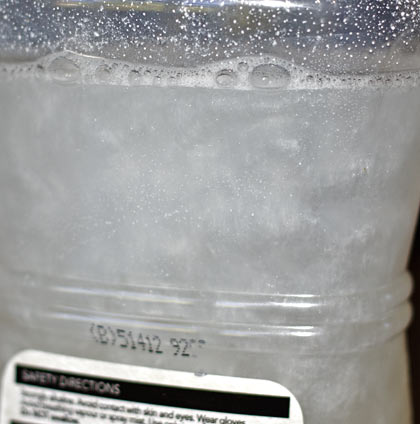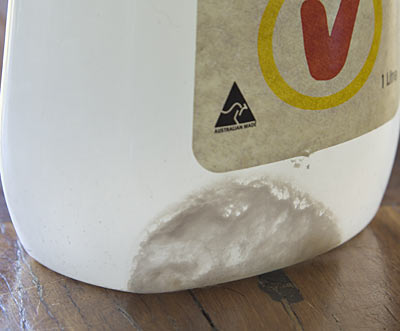A reader writes:
Why is "cloudy ammonia" cloudy?
I've used household ammonia for decades now, for cleaning windows and floors and so on, and never really questioned why it has that swirling cloudy look. But the other day I realised that this stuff is just a solution of ammonia (NH3) in water, and I don't think there's any reason why that shouldn't be clear, like a solution of many other simple chemicals in water.
Where do the clouds come from?
Jennifer
Some readers may be confused at this point, because different parts of the world have different kinds of supermarket ammonia-water. I think cloudy ammonia is the standard kind in the Commonwealth, with the non-cloudy version being normal in the USA, but don't quote me on that.
For those who haven't seen the cloudy kind...
...here some is. It's really quite pretty; you can see a similar pearlescent swirling effect in various shampoos that're trying to persuade you they're not just detergent.
Jennifer's right, though: There's no reason why ammonia in water should look like this. Bubble ammonia into water and you get a solution of ammonium hydroxide, which is clear.
The reason why cloudy ammonia is cloudy is simple enough: The manufacturers put soap in it. I've also read that there can be some oil or other instead of, or in addition to, the soap. In any case, the additive makes the substance look interesting, and may also make it a better cleaner. Probably not a better window cleaner, though, since straight ammonia-plus-water will evaporate to nothing and not leave marks, while ammonia-plus-water-plus-soap can leave streaks.
The ammonia in the above picture had been sitting undisturbed for some time, so it wasn't actually very cloudy at first...
...because a lot of its "clouds" had settled out. I took this photo first, then shook the bottle up and took the other one.
While we're on this pungent subject, I have recently accidentally created an ammonia-water generator.
We have, you see, four indoor cats. They use cat litter fast enough to make "flushable" litter a pretty quick ticket to a drain blockage, if you're dumb enough to actually flush it, which, at one point, I was.
Now, next to the phalanx of litter trays, there's a flip-top rubbish bin that I shovel the nasty stuff into for later, non-plumbing disposal.
Urine, left to sit, generates ammonia from the breakdown of urea.
(If your surname is "Fuller", then someone in your ancestry was probably rather familiar with this phenomenon.)
All that ammoniacal goodness is contained very effectively by the bin's fitted lid. It only comes out to say hello to my sinuses when I've got the bin open. It's less gross than you'd think, too; it doesn't really smell like wee and poo at all, because the wall of harsh ammonia-smell covers everything else.
When the litter stays there a bit longer than usual, it warms up a bit from its own slow decomposition. When the ambient temperature was about 20°C, I measured the temperature in the middle of the litter at around 26°C.
When this has happened and I open the bin, the ammonia-smell is really strong, and the underside of the lid is covered with droplets of quite clear, clean-looking liquid. Which is ammonium hydroxide; a solution of ammonia in water. It's probably got a high enough pH to be pretty much sterile, too; if I were more dedicated to perversity, I could bottle it and use it as a cleaner.
Oh, and while we're on the subject of well-aged urine, if you're unhinged enough to boil down aged urine, you can isolate phosphorus.
Or possibly not.
Psycho Science is a regular feature here. Ask me your science questions, and I'll answer them. Probably.
And then commenters will, I hope, correct at least the most obvious flaws in my answer.


25 February 2012 at 1:41 am
Yeah, I bought one of those automatic sweep litter boxes for my 2 indoor kitties and liked it for the convenience - all the poo gets swept into a little container, the urine just soaks into the crystal litter, everything was easy until I did the math and discovered I was spending USD$30-40/month on the litter boxes.
So I "engineered" a solution that uses the top half of a plastic storage bin, puppy training pads, and rather a lot more litter than the official boxes. It works great - I only have to clean it out once a month and the cats don't mind it at all, and the litter cost is halved. But at the end of that month, the ammonia that is trapped in the training pad will curl your eyebrows.
I'm not enough of a chemist to know if there are any worthwhile catalysts or reactants I could use to neutralize it further, but since it's only something I have to face once a month, I haven't looked too closely.
25 February 2012 at 1:55 am
"a solution of ammonia in water. It's probably got a low enough pH to be pretty much sterile, too"
Ammonia is a base, and should give a *high* pH.
25 February 2012 at 11:04 pm
pH means just what I choose it to mean - neither more nor less.
(Fixed.)
26 February 2012 at 5:32 am
It might have been a low enough pOH, which is the inverse of pH...
25 February 2012 at 3:40 am
I also use a little wastebasket. After getting tired of the ammonia and cleanup fun, I also use poop bags to hold the scoopings. Adds a few bucks to their upkeep costs, but totally worth it.
25 February 2012 at 6:22 am
That video is horrifically, gaggingly brilliant.
26 February 2012 at 6:41 am
Interestingly, in the UK, ammonia (at least when I was younger, not seen it in years, not been looking mind you..) was water-clear, so far as I could tell, pure ammonium hydroxide. And yes, having been owned by cats, I know that 'sinus clearing' litter smell well!